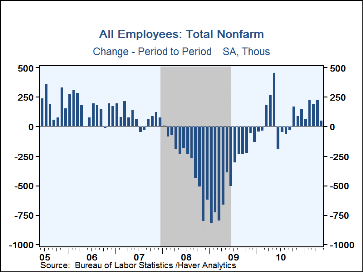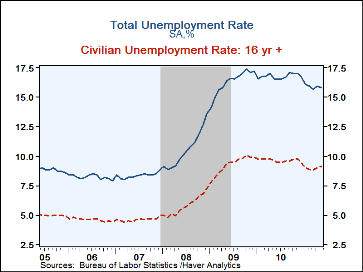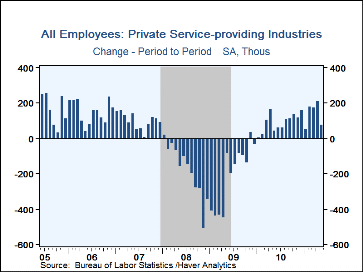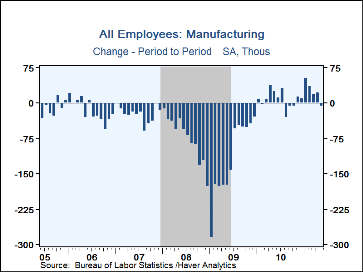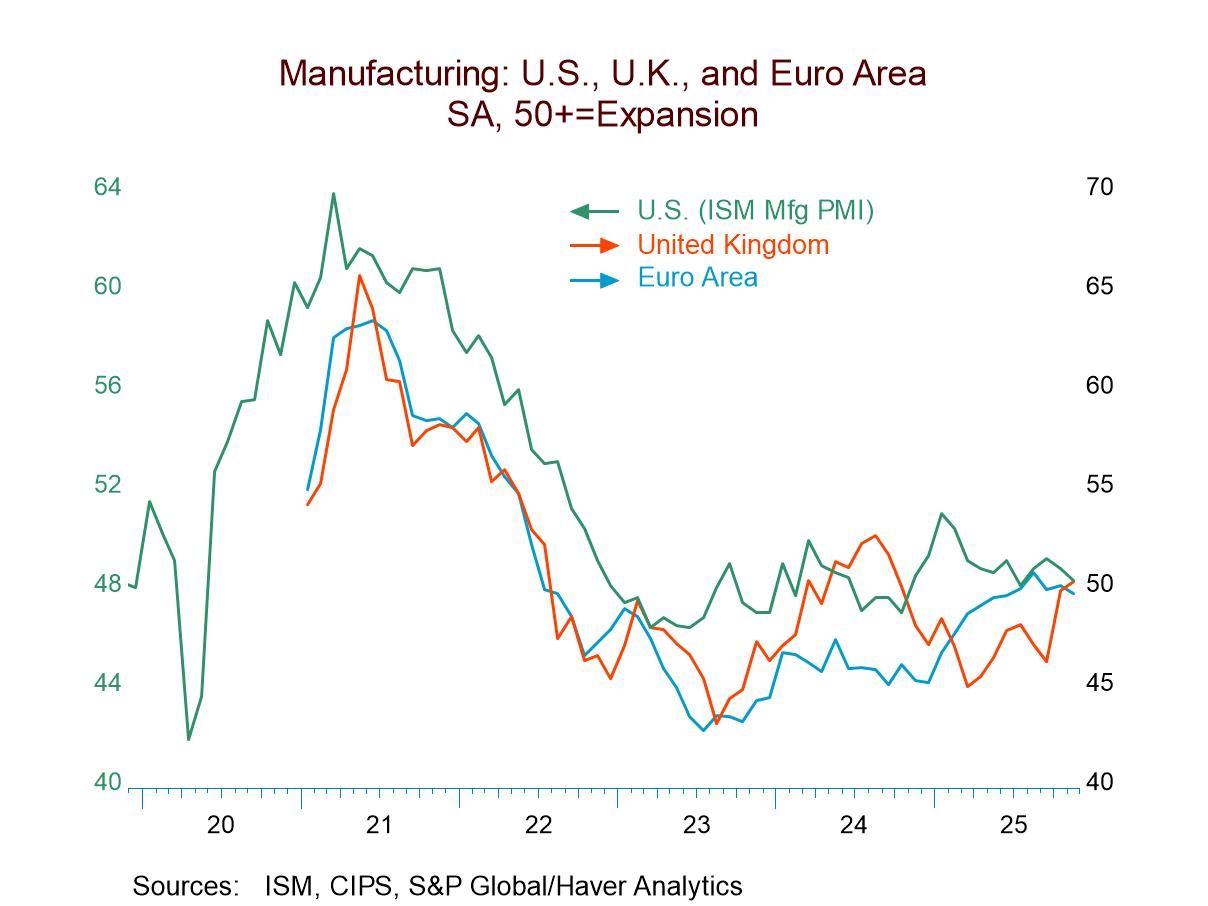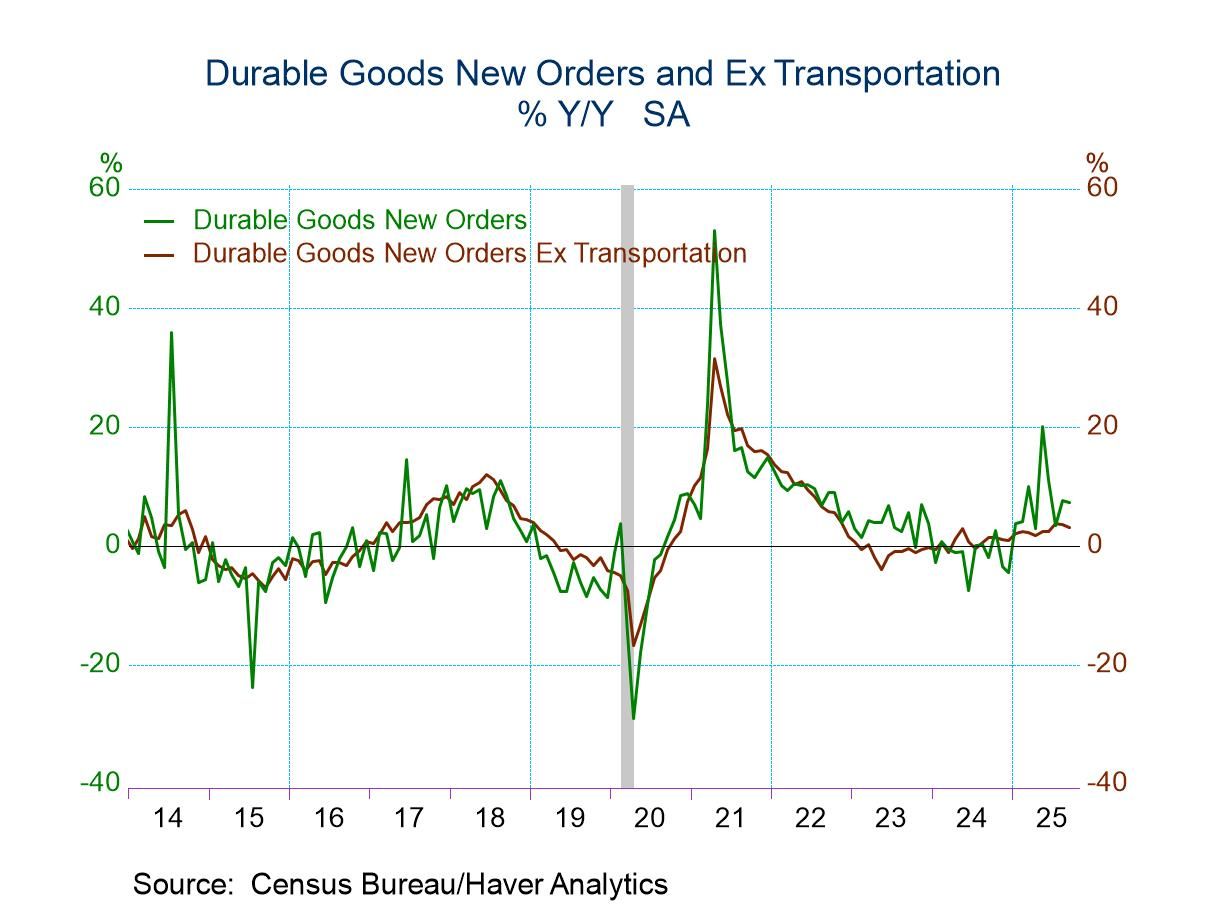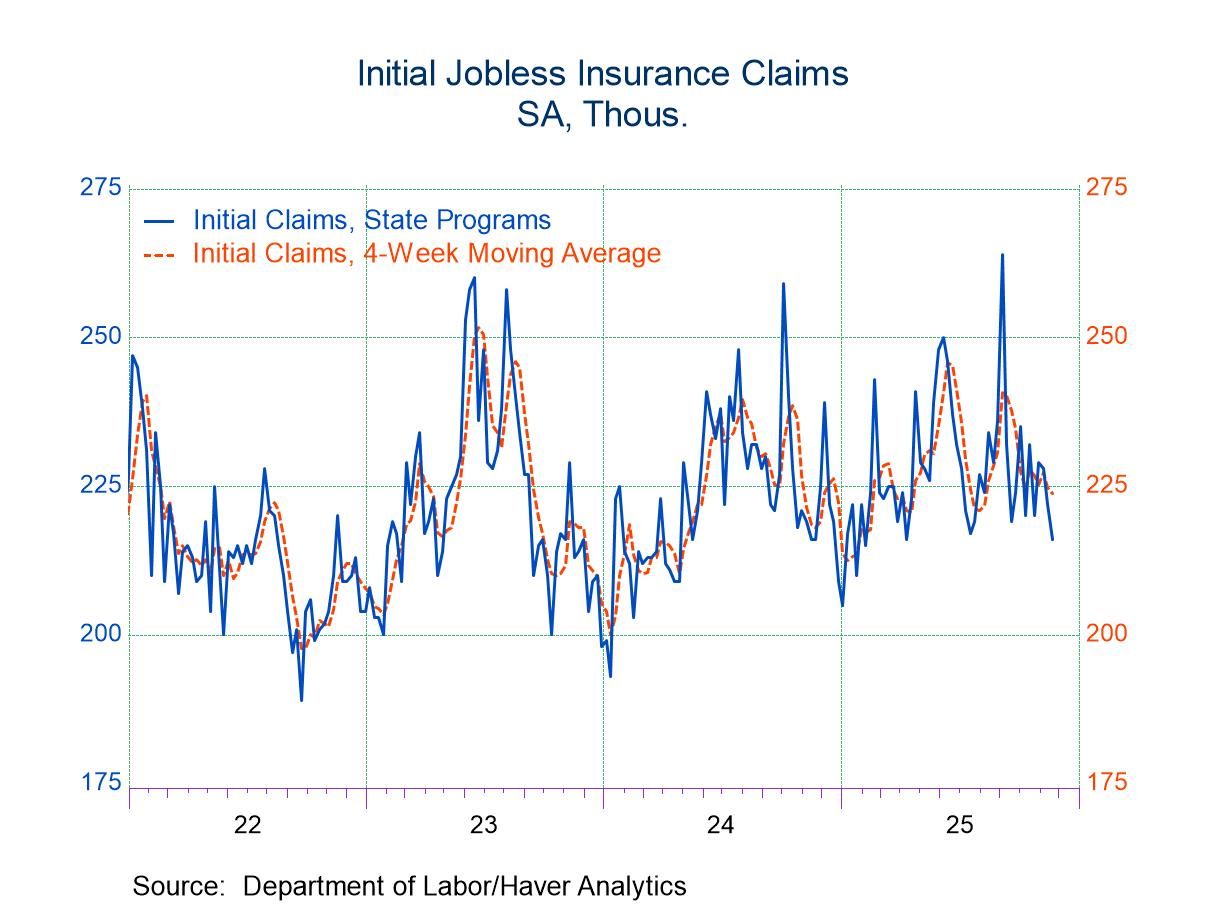 Global| Jun 03 2011
Global| Jun 03 2011U.S. Payrolls Gain Modestly, As Jobless Rate Rises
by:Tom Moeller
|in:Economy in Brief
Summary
The two headline figures from the May employment report were dreary. The Bureau of Labor Statistics stated that the 54,000 worker rise in payrolls was the weakest in nearly twelve months and noted that the unemployment rate rose to [...]
The two headline figures from the May employment report were dreary. The Bureau of Labor Statistics stated that the 54,000 worker rise in payrolls was the weakest in nearly twelve months and noted that the unemployment rate rose to 9.1%, its highest of 2011. In addition, payroll gains in the prior two months were revised down by a collective 39,000. The latest gain in payrolls fell short of Consensus expectations for a 190,000 increase and a decline in the unemployment rate to 8.9%.
From the payroll survey, total
payrolls increased just 54,000 due to broad-based weakness. Factory
sector payrolls fell 5,000, the weakest showing since October.
Construction payrolls also rose just 2,000, the weakest rise this
year. Private service sector jobs, which account for 84% of private
sector employment, rose only 80,000, the weakest gain since January.
 Weakness was led by an 8,500 decline (+0.7% y/y) in retail and a
6,000 decline (+1.6% y/y) in leisure & hospitality. Jobs in
professional & business services rose a steady 44,000 (3.1%
y/y), education & health rose 34,000 (2.3% y/y) and finance rose
3,000 (-0.4% y/y). Government sector employment continued quite
weak. A 29,000 worker decline (-3.7% y/y) was led by a 28,000 drop
(-1.9% y/y) in local government, then a 2,000 slip (-0.5% y/y) at
the state level and a 1,000 increase (-16.5% y/y) in federal
employees.
Weakness was led by an 8,500 decline (+0.7% y/y) in retail and a
6,000 decline (+1.6% y/y) in leisure & hospitality. Jobs in
professional & business services rose a steady 44,000 (3.1%
y/y), education & health rose 34,000 (2.3% y/y) and finance rose
3,000 (-0.4% y/y). Government sector employment continued quite
weak. A 29,000 worker decline (-3.7% y/y) was led by a 28,000 drop
(-1.9% y/y) in local government, then a 2,000 slip (-0.5% y/y) at
the state level and a 1,000 increase (-16.5% y/y) in federal
employees.
From the household survey, the rise in the unemployment rate to 9.1% reflected a 105,000 (0.3% y/y) rise in employment, which just recovered a 190,000 April decline, and a 272,000 increase (-0.4% y/y) in the labor force. Despite the labor force gain, the participation rate fell to 45.1%, the lowest since 2007. The overall unemployment rate, which includes marginally attached workers and those working part time for economic reasons, held at 15.8%. For workers aged 16 to 19, the unemployment rate was 24.2%. The median duration of unemployment lengthened to a record 39.7 weeks as 45.1% of those unemployed have been jobless for more than 27 weeks.
The diffusion index of hiring, showing the breadth of employment gain, fell to 53.6% over a one-month period but remained firm at 70.4% over a six-month span.
Average hourly earnings rose another 0.3% as earnings in the service-producing sector rose 0.3% (2.1% y/y) and factory sector earnings ticked up 0.1% (1.8% y/y).
The figures referenced above are available in Haver's USECON database. Additional detail can be found in the LABOR and in the EMPL databases. The expectation figures are from Action Economics and are in the AS1REPNA database.
| Employment:(M/M Chg., 000s) | May | Apr | Mar | Y/Y | 2010 | 2009 | 2008 |
|---|---|---|---|---|---|---|---|
| Payroll Employment | 54 | 232 | 194 | 1.0% | -0.7% | -4.4% | -0.6% |
| Previous | -- | 244 | 221 | -- | -0.5 | -4.3 | -0.6 |
| Manufacturing | -5 | 24 | 20 | 1.4 | -2.7 | -11.6 | -3.4 |
| Construction | 2 | 5 | 5 | 0.0 | -8.1 | -16.0 | -6.1 |
| Private Service Producing | 80 | 213 | 179 | 1.7 | -0.1 | -3.5 | -0.2 |
| Government | -29 | -19 | -25 | -3.7 | -0.3 | 0.3 | 1.3 |
| Average Weekly Hours | 34.4 | 34.4 | 34.3 | 34.2 (May'10) |
34.1 | 33.9 | 34.5 |
| Average Hourly Earnings | 0.3% | 0.3% | 0.0% | 2.1% | 2.4% | 3.0% | 3.8% |
| Unemployment Rate(%) | 9.1 | 9.0 | 8.8 | 9.6 (May'10) |
9.6 | 9.3 | 5.8 |
Tom Moeller
AuthorMore in Author Profile »Prior to joining Haver Analytics in 2000, Mr. Moeller worked as the Economist at Chancellor Capital Management from 1985 to 1999. There, he developed comprehensive economic forecasts and interpreted economic data for equity and fixed income portfolio managers. Also at Chancellor, Mr. Moeller worked as an equity analyst and was responsible for researching and rating companies in the economically sensitive automobile and housing industries for investment in Chancellor’s equity portfolio. Prior to joining Chancellor, Mr. Moeller was an Economist at Citibank from 1979 to 1984. He also analyzed pricing behavior in the metals industry for the Council on Wage and Price Stability in Washington, D.C. In 1999, Mr. Moeller received the award for most accurate forecast from the Forecasters' Club of New York. From 1990 to 1992 he was President of the New York Association for Business Economists. Mr. Moeller earned an M.B.A. in Finance from Fordham University, where he graduated in 1987. He holds a Bachelor of Arts in Economics from George Washington University.


